YouTube as a website and community bursts with positivity and good vibes. It’s also a cesspool of divisive discourse, which can sometimes turn into harassment. You’ll find all that and more at VidCon.
VidCon, founded by the vlogging brothers Hank and John Green in 2010, is a convention designed for YouTubers, streamers, and other video makers to meet and network. VidCon 2017, which I attended, took place at the Anaheim Convention Center in California last weekend. It’s basically three conventions in one. The first floor is for people with “Community” passes — the fans. It has the air of San Diego Comic Con.
There are meet-and-greets for big YouTubers like Markiplier and Miles Chronicles, merch booths to pick up swag, and a bunch of places to take really great Instagram photos. The Taco Bell booth is blinged out in metallic decorations, the Oasis Chill Zone has a hammock for napping, and Instagram’s booth has a photographer and circular swings — perfect for your new Twitter icon.
The second floor has an entirely different vibe. This is for the people on the “Creator” track, the people trying to grow their channels and meet new collaborators. They attend panels about entertainment law hosted by savvy twenty-five-year-olds, exchange business cards, and attend networking meetings. It’s all very professional. These people might be young, but they’re serious.
The third floor is for industry only — the people trying to use the people on the second floor to serve ads to the people on the first floor. These are the people ostensibly running the show, but their programming is all about how to adapt to new trends that the creators are driving. If you don’t know how to work with vertically oriented videos or you want to know what kind of influencer can help your brand, this is where you’ll find help on those topics.
Each floor is connected by an escalator, and as I ascended them I felt like I was joining some secret club. The second floor even had a balcony where I could look down on the community members below. But on each subsequent floor, the mood got more serious. Emerging into the creator track floor felt like a huge bummer after trawling through the excited crowds on the first floor. The carpet was grey, the walls were beige, and there were no sets for you to take pictures. While the creators and industry members on these upper floors were still excited to be there, on the upper floors it was easy to get bogged down in a conversation about what people don’t like about YouTube. There was less excitement, more cynicism and gossip.
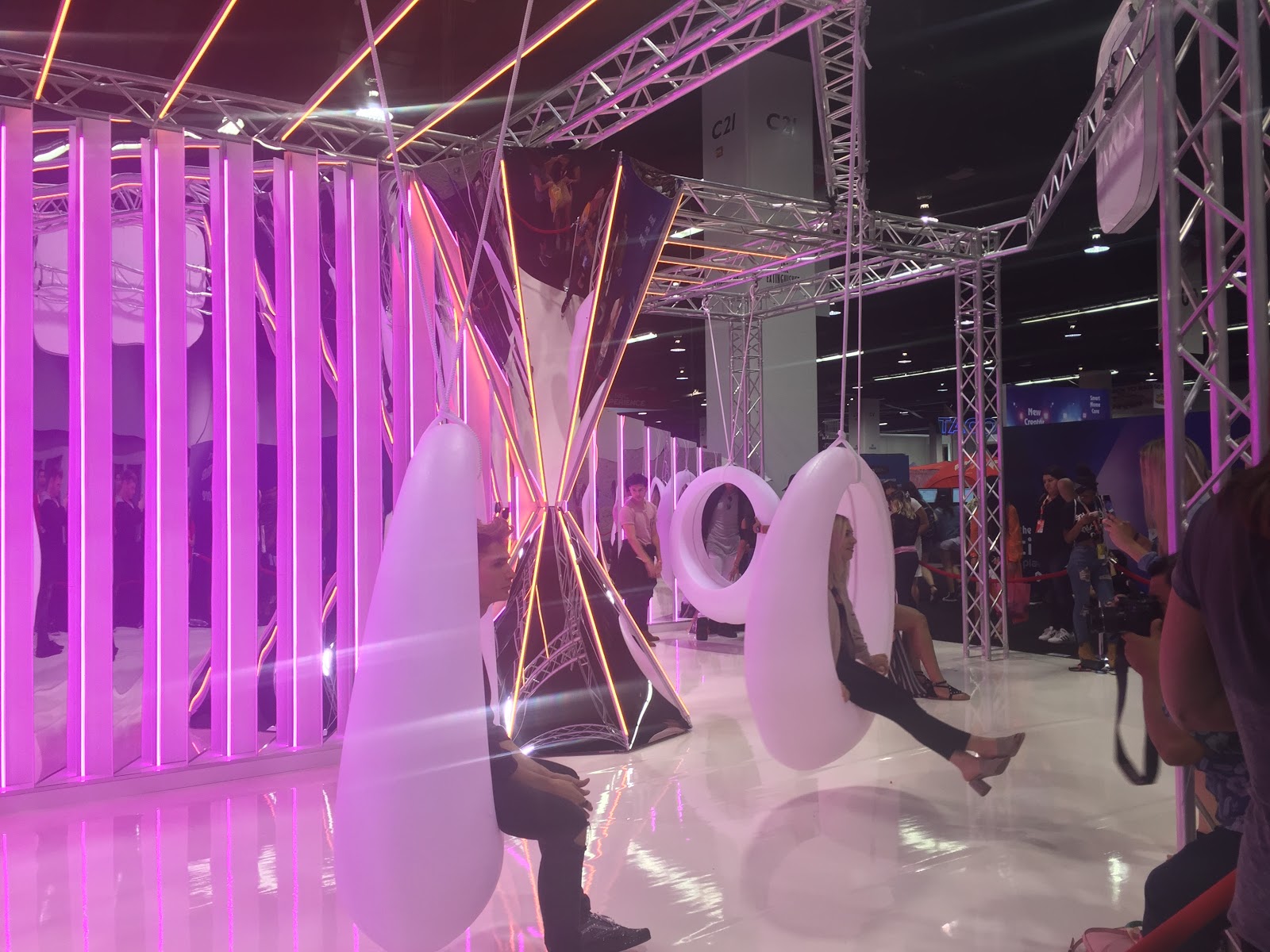
People waiting for photographers at the Instagram booth.
Throughout the con, you’d see young people with cameras. These cameras were always on. The first thing I heard after dropping off my bags was a teenager saying, “What’s up, Snapchat?” While making my way to the very expensive but delicious taco truck, I dodged young people with their cell phones on selfie sticks, or their DSLRs in their friends’ hands, recording take after take about their experiences at the convention. I ran into a guy with a camera on a small tripod sitting in the hallway of my hotel. He had just finished making a video, and was trying to get a chance to eat. He gave me some of his Twizzlers.
It’s easy to think of these people as self-obsessed. They were all expertly manicured. Every last one of them had perfect hair and dressed in bold colours. Some of them were inconsiderate, as you might have expected. They would stand where they should be walking; at one point, I spotted a semi-circle of pre-teens completely blocking the convention’s entrance because they were staring up at someone on the balcony. There was an Instagram model who yelled at a security guard, calling him poor and ugly.
But the people I spoke with came off as excited, telling me that they were at VidCon because they wanted to learn how to help people.
Rachel Ann Pierce, who makes vlogs to encourage people to be more outgoing and do what they love, has been to VidCon four times. “I come back every year to meet with the community that I’ve built there,” she said. “VidCon helps me feel connected to the larger YouTube community and inspires me to keep making things.”
For her, and the other seven creators I talked to, this convention puts them in the same room as their peers and gives them a chance to spread a message of positivity. For fiteen-year-old creators B and December, whose father requested that we not use their full names, the chance to meet their favourite stars wasn’t just an opportunity to interact with people they look up to, but to get advice on how to become YouTubers themselves.
“The community as a whole seems like such a fun thing to be a part of. Everyone is so supportive of each other and it’s a fun place to be,” B said. “It’s amazing that a person aspiring to a YouTuber can talk to an actual YouTuber. I talked to people like [LGBT vlogger] Ash Hardell, and they will be like, ‘Yeah, you’re gonna do great.’”
This positive outlook seems at odds with the stories that laypeople hear about YouTube as a service. The narratives that dominate most conversations about YouTube involve boundary-pushing jokes, advertisers leaving the platform, and most worryingly, harassment. While the attendees I spoke to all had a good time, these aspects of the platform were also present in their experiences at VidCon, the real-life version of YouTube.
On Friday, the first day of programming at VidCon, a panel called Women Online Discussion (described as a group discussion led by YouTube women to “foster new creators and communities, amplify often-marginalised voices, and move forward together”) went off the rails. During the panel’s opening moments, panelist and feminist video game critic Anita Sarkeesian pointed out an audience member, YouTuber Carl “Sargon of Akkad” Benjamin, who was in the front row. When asked why panels about what it’s like to be a woman online are necessary, she said, “I might be wrong but there is someone in the front row who is a notorious harasser of mine filming this panel, so I think it’s important to keep having these conversations.”
She wasn’t wrong. At the panel, I saw Benjamin and crew take up the first three rows on the right hand side of the stage, some of them with cameras out, livestreaming and talking to their audiences as if they were a YouTube comments section come to life. Panelist Ahsante Bean told me later that Sarkeesian and others knew to expect rabble-rousing. “[Sarkeesian] had said that people had tweeted at them to make sure they knew that they were coming,” Bean said. “They were very obviously recording video in the front row that was clearly going to be dissecting it later.”
Sarkeesian has long dealt with harassment online and has clamped down on debate under her videos, closing the comments sections. Her critics say she’s not interested in debate, but at this panel, she showed she was more than willing to fire rounds of her own. “If you search my name on YouTube you get shitheads like this dude,” she said, referring to Carl Benjamin, “who are making these dumbass videos that just say the same shit over and over again. I hate to give you attention because you’re a garbage human, but the fact that these dudes are making endless videos that go after every feminist over and over again I think is part of the issue of why we need to have these conversations.” Benjamin, a prominent GamerGater, has indeed made several dozen videos about Sarkeesian, routinely berating and criticising her.
Then came time for audience Q&A, a rare chance for Sarkeesian’s fans and critics to ask questions that was instead dominated by harassment. The vlogger Rachel Ann Pierce, who attended the panel, described it as “unexpectedly tense.”
“When they opened it to audience questions is when everything really went to shit,” Pierce said. “One man was taken away from the mic and continued shouting about how women should be able to handle being called a bitch online. Fine, but they shouldn’t have to.”
Ahsante Bean seemed similarly frustrated by how the panel went down. She has been to VidCon three times, and in previous years, the Women Online Discussion panel left her feeling upbeat. This year, she left feeling frustrated. “During the Q&A, particularly, I was disappointed that more women on YouTube that were looking to be a part of the community, that are looking to support other women, didn’t have a chance at the mic,” she said. “That was really the saddest part for me, that the Q&A … wound up giving these harassers more of a platform to voice their warped perceptions of what they thought we were doing.”
YouTuber Bunty, who asked that I not use his real name, attended the panel alongside Benjamin. During the audience Q&A, as the man was taken away from the mic for yelling that women should be able to handle harassment, Bunty supported him, shouting “women are powerful.” Bunty later made a video saying he wished Sarkeesian had talked about her “positive experiences” rather than acknowledging Carl Benjamin.
Like everyone else at VidCon, Bunty came to the convention to meet the people he interacts with online. One of those people was Benjamin. Bunty told me he has not actually seen the videos that Benjamin has made about Sarkeesian, but he “[imagines] they are very similar to the criticisms many other people have of her.”
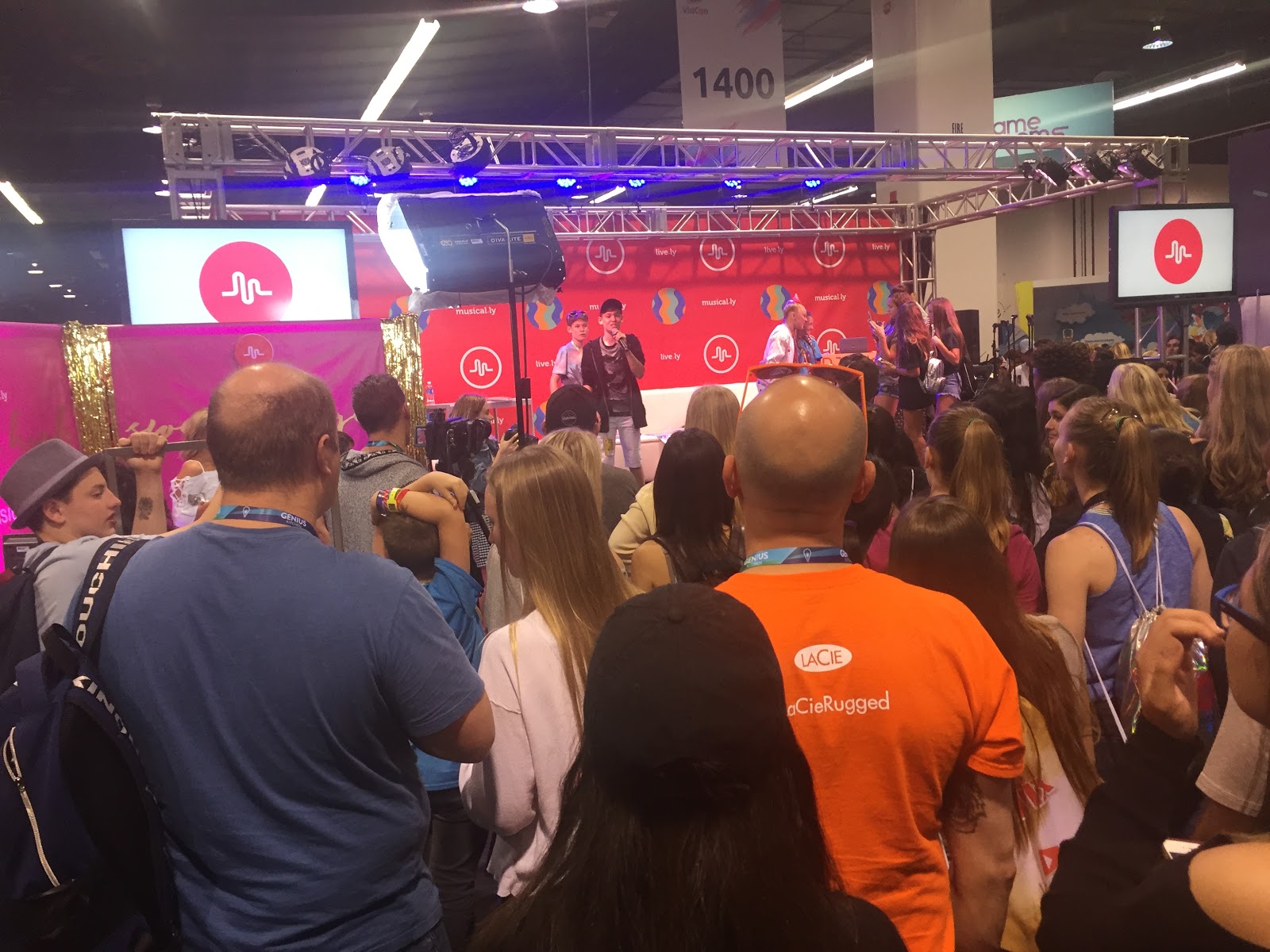
The booth for Music.ly was always this crowded.
Bunty is part of what he calls the “commentary community” on YouTube, which is a group of people that make videos about political topics, often framing themselves as pundits or jokers. Some people in this community respond to specific people about specific vlogs, often recutting and recontextualising them to make their point, or to mock other people’s content.
Bunty has a vlogging series called “Let’s Talk,” where he talks into a camera about his take on various social issues including white genocide (“The reason why this idea of white genocide exists … is because the mainstream media fucking sucks. All they’re doing is putting white people into a corner and the other people into another corner and compartmentalising it even further”) and feminism (“There is a major social divide and that is being fuelled by the media”). Like several other prominent YouTubers, including some who were at VidCon, Bunty made videos about games before he switched to political commentary.
“I went to VidCon last year but I was more of a normal YouTuber,” he said. “I was very innocent. I didn’t know what my voice was going to be on the platform. In fact my schtick was … I thought I had to be this dopey Indian dude, I thought I had to be a caricature of sorts.”
Bunty, like everyone else I spoke to, sees himself as a beacon of positivity. In his videos, he jokes around and laughs, even while discussing terrorism or his experiences with anti-Indian racism growing up. He said he met fans at the convention that said his work had made them less aggressive. Bunty said it was a lack of positivity that bothered him about the panel. “When she called [Benjamin] a garbage human, it pretty much just made the entire group look like a bunch of trolls that were there to harass her,” he said, “and it turned into this really negative panel, I couldn’t help but think that all they were talking about was negative experiences.”
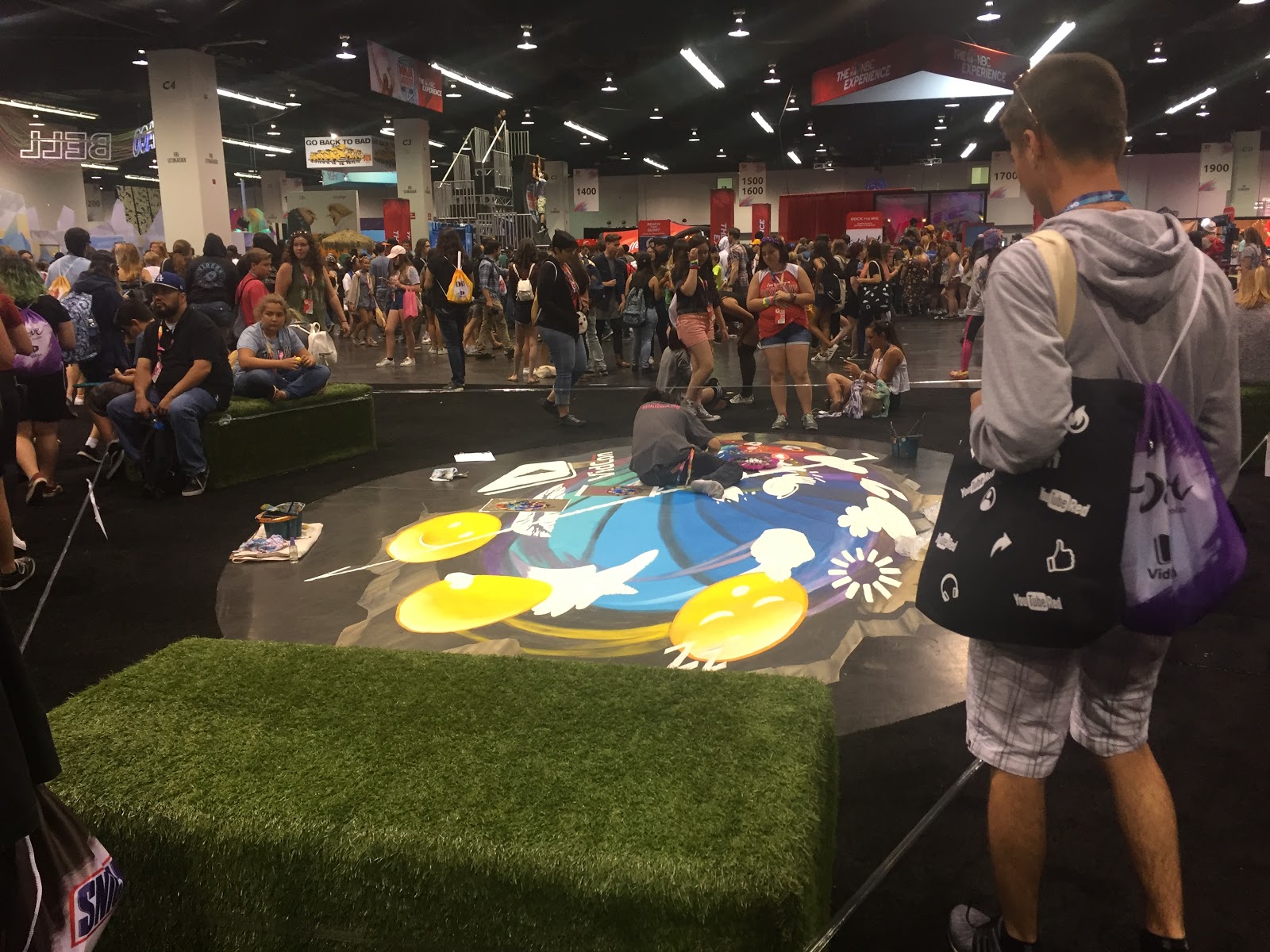
On Friday, artists painted a mural in near the Twitter Community Stage.
“I can imagine that they get a ton of harassment,” Bunty said. “I’m sure it sucks. I can’t even begin to imagine that kind of harassment. That sexually charged harassment. I get that — I get racially charged harassment. I don’t get rape threats, I don’t get that stuff. But… it didn’t feel like the harassment [Sarkeesian] was talking about was that harassment.”
Sarkeesian would later tell Polygon that she “certainly [has] no regrets” about calling Benjamin out. “This is a man who has spent years driving harassment toward me and other women online,” she said. “Under the circumstances, considering his pattern of behaviour and everything he’s put me and others through, I’d say ‘garbage human’ was one of the kinder things I could have called him.”
Other VidCon attendees who weren’t at the panel said they were vaguely aware that something had happened. December told me that she had heard that a rude comment was made at a panel, and attendee India Petersen, who currently has a music channel and follows some feminist YouTubers, said that she had heard on Twitter that there had been a tiff of some kind. Everyone I spoke to was aware that harassment on YouTube as a platform was a very real possibility for everyone that participates in it.
But these people knew that before they got here. While it worries some of them, it isn’t going to stop them from making videos or attending the real-life version of YouTube. Besides, being here, in close proximity to people who have already made it, can give aspiring YouTubers like B and December practical answers to their burning YouTube questions.
“If you flag down a YouTuber who has time, they’re definitely willing to talk to you and give you advice,” B said. They actually ended up on stage with LGBT YouTuber Miles Chronicles during a panel, and they say that they have already lined up interviews with other interesting YouTubers that they will post once their channel goes live.
One bizarre VidCon trend is the number of times you’ll hear the word “networking” or the phrase “making connections” come out of the mouths of fifteen-year-olds. Even on the first floor, in the community level, you can tell that everyone is here for business. Despite the carousel and food trucks outside, people aren’t really here to chill out and soak in the vibe. When they attend Q&As, they ask business minded questions. Their favourite YouTubers will tell them about the importance of getting a lawyer, a manager and an agent. They don’t just want to meet the people they admire — they want to learn from them, and hopefully become them.
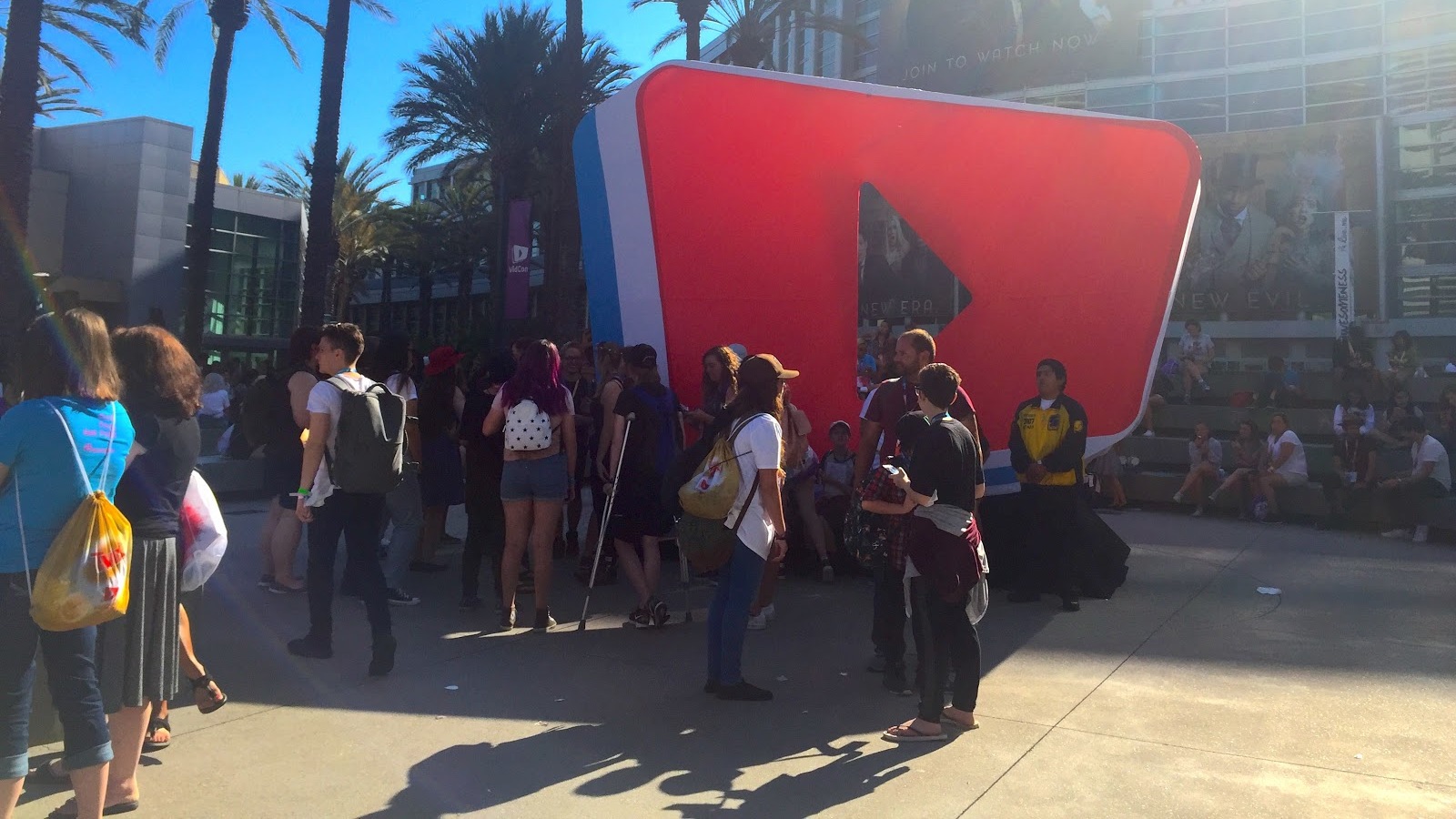
During Markiplier’s Q&A on the Twitter Community Stage, he said to his fans, “You can be on this stage in four years.” That’s technically true. Mark has only been a YouTuber for five years. The audience cheered after hearing this. To be fair, they cheered after almost everything he said but they also know Mark and they know his story. They know that, in his words, he’s just a small town guy who fell in love with making videos and is now featured in Forbes as a top influencer of 2017. He’s now got over 17 million subscribers and makes 5.5 million dollars a year.
The reason VidCon exists is because those fans want that to happen to them — even if that means brushing up against unsavoury parts of the platform in the process.
Pierce told me that VidCon for her is about networking, building her knowledge, and community, and she met some creators she admired. “Some of them were amazing humans that I’m so happy to start calling my friends,” she said. Ahsante Bean described it as the only time of year that she and her peers all get together. For small channels and aspiring creators, this is their chance to break into that community, and they’re going to take it.
Sometimes, as they schmooze and pass out business cards, there’s a quiet desperation in their eyes, and creators I spoke to told me that this job can be a lonely grind. But when I engaged with B on their plans for their new channel, the original songs and poetry they’re planning on uploading, their voice rose with enthusiasm. This year, they were attending on the community track. Next year, B’s parents said they’d buy the fledgling YouTuber a creator pass.
Bean said that her experiences at VidCon 2017 were more difficult than previous years. This year, unlike the others, VidCon became a manifestation of the cultural war that has raged across YouTube for at least half a decade. “VidCon in the past has kind of been this great place where everyone’s happy and gets along, everyone’s likeminded,” she said. “It’s kind of like an escape.”
But, she added, it was still a positive experience overall. “There were women in the audience, and there were women who … felt overall encouraged by the con and weren’t discouraged,” she said. “In all things balance, but there’s definitely a lot of great content out there, and great young content creators.”
Attending VidCon was like entering a real-life manifestation of YouTube, along with all its best and worst traits: the divide between business people and creators, separated literally by floors; the optimistic energy of teens who want to be video superstars; the commenters who show up to get a rise out of you. The only thing missing were the copyright strikes.
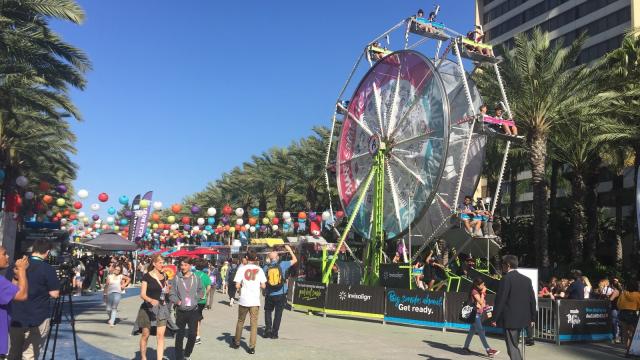
Comments
25 responses to “For One Weekend, The Drama Of YouTube Comes To Life”
Really? People would rather be serious about networking and growing their YouTube careers instead of having a realistic career plan that’ll keep them employed after the age of 35?…
While I tend to agree that too many people think that they can bee the next Neistat or Defranco in terms of sustainable income; I would also counter argue that it is better than getting stuck in a minimum wage going nowhere job.
This is a relatively close-minded approach to YouTube and content creators in general. People have, for years, been making and living off the content they create and upload to YouTube. With the advent of services like Patreon, this will only continue to happen.
The recent crash of YouTube and it’s ad-revenue has hopefully shown a lot of newcomers to the scene that it won’t always be rainbows and lollipops, but people are bouncing back by finding their own advertisements and making their own way. This alone teaches people a lot about managing a situation and building relationships with external organisations.
I started making videos for YouTube a while back, just gaming ones I release at the rate of one per week that I record, edit and upload on a schedule alongside my day job. This has helped me in my standard day job with time management, speaking freely and has given me a truckload of self confidence.
I really don’t think you should think so lowly about people that want to get serious about a YouTube career. It’s a reality.
I can’t help but wonder if these kids who are vlogging and chasing the YouTube dream are going to damage there future by having their entire lives essentially online.
I’m not talking about the gamers but more the general ones like the 15 year olds spoken about in the article. Are we going to end up with large group of kids/young adults who chased this lifestyle so hard that they come out of other end dejected and without employable skills?
We are well overdue for another internet related crash. And pretty much anyone who doesn’t already have some kind of financial stability will be hit really hard by it.
The internet needs a 1983 video game crash style event to happen… with Twitter and Youtube being the buried ET games in the desert
Lol Anita is cancer. Sargon shit show aside (both were/are horrible), the way she treated Boogie (and the other panelists), yet didn’t get repremanded for is ridiculous and the fact that she was apologised to by one of the founders is even worse.
She has every right to be angry at Sargon, but to think that it is ok to bully not only him, but also the other panelists when he hadn’t even done anything is a reflection of her character and how it must always be about her.
The fact that she tried to play down other people’s hardship on a panel about bullying makes my skin crawl.
She is a horrible person.
“Lol Anita is cancer” – Way to completely destroy any credibility your arguments could possibly make. If you want to make the argument that Anita Sarkeesian’s methods are questionable to someone who doesn’t already subscribe to that theory, try not using that language. Right now, you’re just supporting her hardline actions.
Lol ok. So criticism (though admittedly rough) is supporting her horrible ideas (UN should police what people can do and say online). I am sorry, but that is the most ridiculous thing ever; I am not going to sugar coat what is essentially a desperate attempt for attention.
I wouldn’t be surprised if she was not in fact a feminist, but instead people were just being taken for a ride (and a payout).
Zero sympathy.
I don’t really have any interest in debating her ideas here (let’s be honest, nobody wins arguments like this on Kotaku, it just reinforces “us vs them” mentailty and I’m too tired for that). I’m just pointing out using language like that demeans your own arguments. I don’t agree with what @weresmurf posted underneath me, either, but the language used is inviting people to decide for themselves.
Insults and conjecture turns your posts into a reader dividing statements rather than an convincing arguments. We’re Kotaku AU, not Kotaku US.
Oh I know, that is why I admitted it was rough. I like to think that I try to invite the ideas that don’t quite align with my own (I am subbed to Franchesca, Laci and Marina), but Anita actually rustles my jimmies really bad. I think it is the way she carries herself and as i said; the panel was an example of her as a person.
She attacked just about everyone and tried to belittle their struggles on a panel about bullying of all things.
Cancer is a bit harsh. She’s more like garbage.
This completely misrepresents what happened. I dont much like Sargon but youre glossing over Anitas narcissistic approach to everything. Bullying Boogie and making everything about her. After watching the footage of the panel and the incident what youve written doesnt match what happened. To borrow a phrase from scumbag Trump, this borders on “fake news”.
I really endorse the idea of others looking into multiple sources for this rather than going by this.
And Polygons article was abhorrently biased fyi.
Wholeheartedly agreed. Polygon and Kotaku, I’ve noticed, tend to show a strong bias and don’t always engage all sides involved in the conflict. In this case, Sargon could have been pursued for an interview but wasn’t, thus we only get Anita’s viewpoint as if hers if the only one that matters. Fortunately, anyone who cares to see what actually happened can go to Youtube and watch a myriad of footage and interviews about this incident in particular to get the other side’s view, as well as Anita’s own videos explaining her actions. For the record, if Sargon had been on the panel and had called out Anita in such a way, then I would be pointing the finger at him instead; in fact I was disappointed when he pretty much did just that in an interview the other day as a response to the Vidcon incident.
What I don’t get about this is why Anita gets to blatantly violate Vidcon’s T’s&C’s by very publicly attacking an audience member from a position of power without them having a platform to defend themselves, and then not have to face any consequences for those actions. At least on Youtube, both parties have a platform to defend themselves or even come to the table and and discuss topics with some civility. Oh right; double standards. Got it.
I don’t even care about the Sargon stuff, I don’t know enough about that situation to have an opinion, but the Boogie thing…
Bullying another panellist because she felt his message of unity of promoting positivity to fight harassment took away from what she was saying, and that his story of him and his friend almost being assassinated marginalises the harassment women face online everyday?
Bullying another panellist should not be ok, full stop. Bullying another panellist because they take the attention away from you, and, in her eyes, deteriorate your victim status? How sad and self centred do you have to be to do that?
I think Anita has a lot of good points, but I’d say her behaviour over the years has done just as damage as her ideas have done good. Big props to Boogie for sticking it out and having a rational discussion with her after the bullying.
Completely agree.
Whilst I don’t like Anita for her inability to accept criticism, I can totally understand that her years of putting up with harassment & vitriol online has definitely affected her negatively and skewed how she sees any situation.
Even so, that does NOT excuse how she handled herself at the event (especially to Boogie). She performed the very thing she argues against and received no punishment for it.
The thing with Sargon is especially interesting because of his earlier interaction with Laci Green, who is another person whom Sargon has been highly critical of. Yet they met up and discussed their differences, to the point that they’ve possibly made amends. After that I could believe that he just wanted to hear and potentially discuss opinions with Anita, but instead was singled out and insulted.
Most of the “drama” from Vidcon seems to center around Anita and the way she handles herself, other panelists, and audience members. There’s video evidence of Sargon doing nothing but sitting at the panel. He doesn’t call out at her, try to belittle her while she talks, nothing. Anita scans the room, notices he is there and calls him out as an example to earn some “victim cred” before getting the “you go girl” moment by harassing him from a position of privilege and power (Anita is one of the very few people who were PAID by the event to attend).
Later, during a panel on Online Bullying of all things, she belittles Boogie2988 and other fellow Youtubers and their experiences to make herself seem a lot worse off than she really is, to the point that poor Boogie had to change the way he speaks, acts, addresses topics and everything else just to appease Anita… Which still had him on the edge of an anxiety attack the whole time… Then he gets abused by her after the panel because he wanted to be positive instead of her constant negativity. The guy is so shit scared from the meeting that he has spent the better part of three days defending her abuse and negative attitude like a battered abused brainwashed housewife!
Then we have to sit through article after article about how “Poor Anita was harassed, it’s like GamerGate all over again” from places like Polygon and Kotaku! When the hell are you lot going to wake up and realize that Anita is just as big of a bully as the people that disagree with her openly!?
Wow, VidCon sounds absolutely shit. Not for any specific goings on, just for the what and why of it. A convention for Youtubers and streamers sounds about as worthwhile as the talking points in this comment thread.
So. Who’s keen for VidCon Australia? xD
Oh mate if Beary is there Im IN.
Beary?
Sorry, “Bearing”, he’s pretty entertaining. Can’t say I agree with everything he says but he’s good value for entertainment in a yobbo way.
Don’t forget Sugartits. They’d definitely both be there.
This sounds like my own personal hell.
Kotaku’s anti-Youtube crusade continues, with blatant bias and misrepresentation of facts once again the order of the day.
Disgusting really doesn’t even begin to describe the ‘journalism’ on display here.